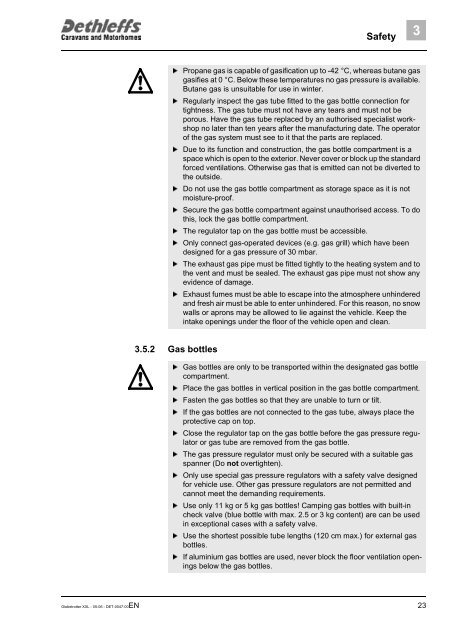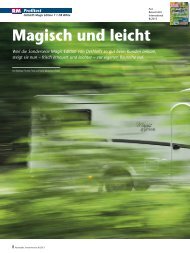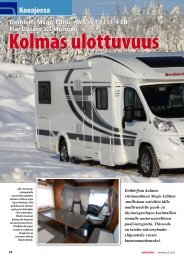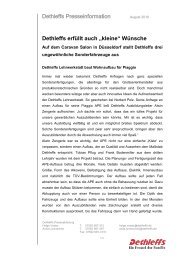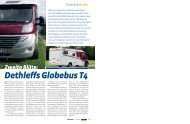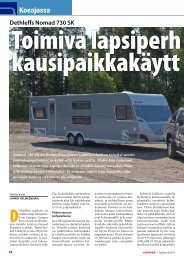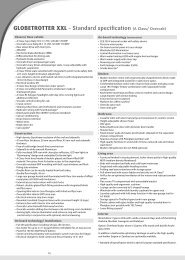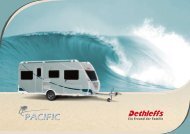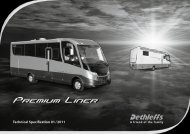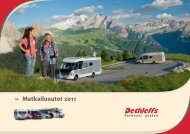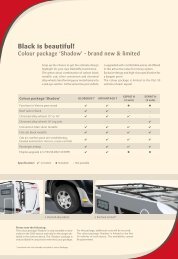User Manual XXL Globetrotter 2006 - Dethleffs
User Manual XXL Globetrotter 2006 - Dethleffs
User Manual XXL Globetrotter 2006 - Dethleffs
You also want an ePaper? Increase the reach of your titles
YUMPU automatically turns print PDFs into web optimized ePapers that Google loves.
Safety<br />
3<br />
Propane gas is capable of gasification up to -42 °C, whereas butane gas<br />
<br />
gasifies at 0 °C. Below these temperatures no gas pressure is available.<br />
Butane gas is unsuitable for use in winter.<br />
Regularly inspect the gas tube fitted to the gas bottle connection for<br />
<br />
tightness. The gas tube must not have any tears and must not be<br />
porous. Have the gas tube replaced by an authorised specialist workshop<br />
no later than ten years after the manufacturing date. The operator<br />
of the gas system must see to it that the parts are replaced.<br />
Due to its function and construction, the gas bottle compartment is a<br />
<br />
space which is open to the exterior. Never cover or block up the standard<br />
forced ventilations. Otherwise gas that is emitted can not be diverted to<br />
the outside.<br />
Do not use the gas bottle compartment as storage space as it is not<br />
<br />
moisture-proof.<br />
Secure the gas bottle compartment against unauthorised access. To do<br />
<br />
this, lock the gas bottle compartment.<br />
The regulator tap on the gas bottle must be accessible.<br />
<br />
Only connect gas-operated devices (e.g. gas grill) which have been<br />
<br />
designed for a gas pressure of 30 mbar.<br />
The exhaust gas pipe must be fitted tightly to the heating system and to<br />
<br />
the vent and must be sealed. The exhaust gas pipe must not show any<br />
evidence of damage.<br />
Exhaust fumes must be able to escape into the atmosphere unhindered<br />
<br />
and fresh air must be able to enter unhindered. For this reason, no snow<br />
walls or aprons may be allowed to lie against the vehicle. Keep the<br />
intake openings under the floor of the vehicle open and clean.<br />
3.5.2 Gas bottles<br />
Gas bottles are only to be transported within the designated gas bottle<br />
<br />
compartment.<br />
Place the gas bottles in vertical position in the gas bottle compartment.<br />
<br />
Fasten the gas bottles so that they are unable to turn or tilt.<br />
<br />
If the gas bottles are not connected to the gas tube, always place the<br />
<br />
protective cap on top.<br />
Close the regulator tap on the gas bottle before the gas pressure regulator<br />
or gas tube are removed from the gas bottle.<br />
<br />
The gas pressure regulator must only be secured with a suitable gas<br />
<br />
spanner (Do not overtighten).<br />
Only use special gas pressure regulators with a safety valve designed<br />
<br />
for vehicle use. Other gas pressure regulators are not permitted and<br />
cannot meet the demanding requirements.<br />
Use only 11 kg or 5 kg gas bottles! Camping gas bottles with built-in<br />
<br />
check valve (blue bottle with max. 2.5 or 3 kg content) are can be used<br />
in exceptional cases with a safety valve.<br />
Use the shortest possible tube lengths (120 cm max.) for external gas<br />
<br />
bottles.<br />
If aluminium gas bottles are used, never block the floor ventilation openings<br />
below the gas<br />
<br />
bottles.<br />
<strong>Globetrotter</strong> <strong>XXL</strong> - 05-06 - DET-0047-00EN<br />
23


